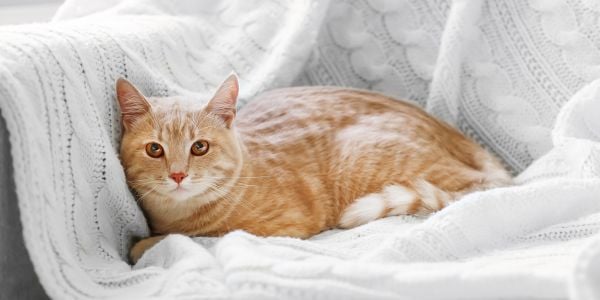 If you're dealing with your cat peeing outside the litter box, the first question in your detective work should be, "Are they soiling or spraying?"
If you're dealing with your cat peeing outside the litter box, the first question in your detective work should be, "Are they soiling or spraying?"
These are two different things (though they often overlap) and are managed in different ways. So, let's look first at how to tell the difference between soiling and spraying.
Then we'll talk about why it's happening, so you hopefully feel less frustrated by understanding the reason behind it.
Finally, we'll talk about tactics to try and resolve this spraying behavior.
Skip to section:
Peeing versus Spraying in Cats
If your cat is emptying their bladder, they're peeing. If, however, they're using small amounts of urine to deposit their scent, they're spraying (also referred to as marking).
It doesn't mean big puddles = peeing and small puddles = spraying. Cats don't make it that easy for us!
Peeing Outside the Litter box
Urinating is generally on horizontal surfaces (though many cats are high pee-ers). If you catch your cat in the act, they're likely squatting, and they may scratch around afterward like they would if they were in a litter box trying to bury their pee. And you'll find less than usual or no urine in the litter box because they’re emptying their bladder in other places.
Unlike spraying, your cat is emptying their bladder, so the puddles are usually larger. You may notice specific areas or materials they repeatedly pee on, like a pile of clothes or the carpet in the corner of the room.
Spraying Outside the Litter box
Spraying is more often on vertical surfaces. You'll usually see a line of urine down the vertical surface that may puddle a bit on the floor. But cats can also mark horizontally while squatting.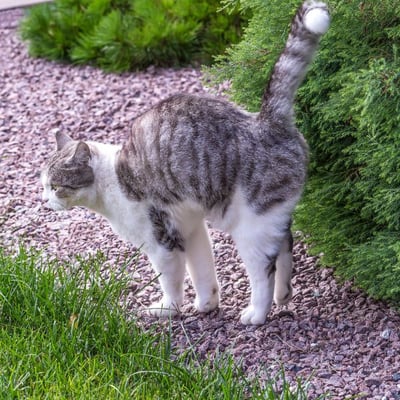
If you catch your cat in the act, you may see them back up against the surface in a standing position, their tail straight up in the air and quivering. They may knead with their back paws.
And a big "tell" is that they won't try to scratch afterward. They may not even sniff around afterward. That's because they sprayed intentionally to put their scent in that spot. So, they don't want to cover it up or need to sniff to ensure it's well covered.
If your cat is spraying around the home, they're likely still using their litter box regularly for peeing and pooping.
Spraying is usually in tiny amounts. And it will happen in socially-relevant places like the area where other pets spend time, near windows or doors (often exterior walls where they may see or smell outside cats), and in places where they may feel stressed or anxious.
It's also helpful to know that cats can use feces to mark (spread their scent) as well. It's less common but can certainly happen. It even has a name. Pooping for the purpose of scent marking is called middening.
Why Cats Spray
Now that you know better whether your cat is spraying or peeing, let's talk about why they spray. For peeing outside the litter box, check out our article on inappropriate elimination, as the reasons for it and tactics to manage it are different than spraying.
So, what does it mean when a cat sprays? As frustrating as it is when your cat is spraying everywhere, it's helpful to know that your cat is doing it for a reason. It's an instinctual reaction solidified through thousands of years of DNA.
They're not being bad or trying to show you they're mad about something. They've been triggered in a very natural, instinctive way, and spraying is their programmed response. Figuring out that trigger will help you solve the problem.
The Most Common Triggers for Spraying
Emotional: A cat will surround themselves with their own scent (both via spraying and urinating) if they're feeling stress, anxiety, fear, etc. This frequently happens when a new pet or baby is introduced to the home or when the home environment suddenly becomes stressful, like when a caregiver is away or the humans in the home are under more stress, and the cat senses it.
Pain or discomfort from medical issues can also be a significant stressor leading to spraying. We provide more detail regarding medical issues below in this article.
Communication: Scent is a huge way cats communicate, just as it is with dogs. I go into the reasons why they choose to spray over other communication methods below.
Territorial: Cats aren't territorial in the "this is mine, and you can't come near it ever" way. They "timeshare." They'll mark to say, "This is mine in the morning, so don't be around in the morning." They'll also deposit their scent as a warning to stranger cats to get them to keep their distance.
Sexual: Intact cats will spray to communicate information about their readiness for mating.
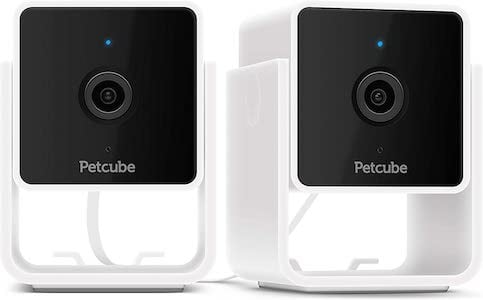
Having trouble figuring out which cat is spraying or whether they're spraying versus peeing? Try a pet cam!
Set up an indoor camera so you not only see who's doing the deed but also the body language and time of day. Those are important clues to determine if they're spraying or peeing and will help identify the trigger.
Note: Just like soiling outside the litter box, spraying can have a medical component. If your cat is feeling stress due to a medical issue, pain, or discomfort, they may spray as a way of self-soothing. So, a vet visit is a good idea, especially if you can't find an obvious trigger. See more about medical considerations below.
Questions? If you'd like to speak with a veterinarian about your cat peeing outside the litter box, Click here
Tactics to Manage Your Cat's Spraying
The different triggers can be managed in different ways. If you're unsure of the trigger, try a combination of tactics and see if you notice any changes. This can help point you in the right direction. If you're addressing the right trigger and giving alternatives to spraying, your cat should stop this behavior. If not, you may need the help of a feline behavior expert. Regardless of the cause, stress reduction should be part of the solution.
Emotional Triggers
Ask yourself some questions.
- Has something changed in my cat's environment or routine that could be causing concern, stress, or fear? A new pet, a new baby, a change in your work schedule, a recent vacation, construction inside or outside, a feeding schedule shift, etc., can all cause distress.
- Has the stress level in the home increased? Cats feed off of our energy.
- Is my cat not getting along with other pets or people in the home?
- Am I offering play and enrichment less than I did in the past?
- Are there any medical issues that could be causing stress?
- Does my cat seem upset by something they're seeing through the windows, like neighborhood cats or raccoons?
If you can put your finger on a specific change or issue, address it.
- For big changes, can you go back to the previous state and slowly make the change in a more positive way? Let’s say you suddenly cut back on your cat’s calories to help them lose weight, or you stopped taking them outside for walks. Instead of those sudden changes, try gradually transitioning over a couple of weeks.
- When changes or new experiences must happen quickly, work on your cat's associations with them. Make good things happen during those new or different things so they’re thinking, “Hey, I get the best stuff (like my favorite treat) when this happens! Maybe it’s not so bad.”
- If there are relationship issues in the home, take steps to improve them. Whether it’s cat-to-cat, cat-to-dog, or cat-to-human, you can help everyone get along better with things like positive reinforcement for calm interactions and making good things happen when they’re together. Setting up cameras in a few places in your home may uncover things that you hadn't realized were happening.
- Offset added stress by doing stress-relieving things like playing or mental enrichment activities and making positive changes to your cat's environment, like adding some perches or comfy places to sleep. You can also try calming treats to help take the edge off for your cat as you work to find and address the cause of their stress.
You can also provide alternative ways for your cat to spread their scent, which can be self-soothing. We'll talk more about that in the next section.
Medical Considerations
As with standard house soiling, a visit to your veterinarian is a vital part of your detective work to manage spraying. Just because your cat seems fine doesn’t mean they are. Cats are incredibly good at hiding illness and injury. That’s because they’re prey animals in the wild and survive by appearing healthy and ready-to-battle at all times.
I’ve seen cats who moved normally and showed no signs of pain other than some changes to their litter box habits. But it turned out they had broken bones. That’s how good they are at powering through medical issues and pain. But they’re certainly feeling the stress of those issues. And that’s what can lead to spraying.
The more common medical causes of spraying and soiling are:
- Discomfort while urinating, which can be a result of urinary crystals and other issues impacting the urinary system.
- Constipation, which is the only time one of my cats would ever pee outside the litter box.
- Joint pain or changes in mobility – often caused by osteoarthritis, which is very common in older cats. You can help your cat by being proactive about arthritis and providing them with joint and other supplements.
- Diabetes and kidney disease cause increased urine production, making it difficult to make it to the litter box at times.
Keep in mind not all medical discomfort is easily diagnosed. You may have a sensitive stomach and feel rotten at times, but that doesn’t mean your doctor can point to a specific illness or issue. The same can be true for cats. So, use other clues like changes in their eating habits, energy level, response to different foods, etc., to help you and your veterinarian pinpoint potential problems.
Questions? If you'd like to speak with a veterinarian about your cat peeing outside the litter box, Click here
Communication Needs
Your cat may be communicating with other cats inside or outside. You may not even know there's a cat outside. But that's often a huge trigger for spraying, which we will discuss in the territory section.
You can't expect your cat to stop communicating in ways that are natural to them. But you can offer alternative ways for them to spread their scent that doesn't involve spraying.
Add surfaces to scratch
Add scratching posts or mats near the spraying areas. Cats have scent glands in their paws and spread scent by scratching. Even declawed cats will go through the motions. Here are a few scratchers our team really likes.
Kitty City Cardboard Scratchers
Here's Mazel getting some enrichment by watching our YouTube bird and squirrel video on his scratch lounger.
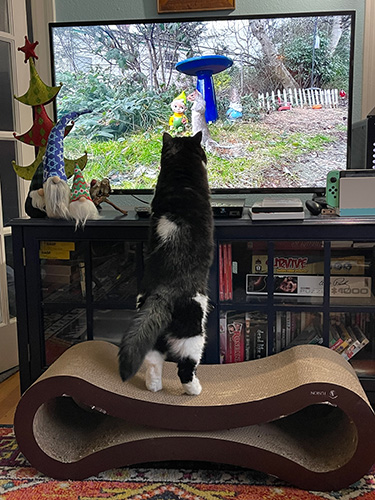
Encourage your cat to roll to spread their scent
Sprinkle catnip or silvervine in the spraying area to encourage your cat to roll around, which spreads their scent without spraying. These are two of my favorite brands of catip and silvervine, Kitty Krack and From the Field.
Spread your cat's scent for them
Rub a clean cotton sock on your cat's cheeks and shoulders to pick up their pheromones. Then, rub the sock around the spraying area to deposit their scent. Do this once or twice a day for a couple of weeks and see if you notice an improvement. Rubbing their face and shoulders on things is a way cats spread their scent, so this could make your cat realize they don't have to "deposit" more sent in the area.
Try a light spritz of Feliway in the spraying area once a day. This product replicates your cat’s “friendly pheromones.”
Add a high-sided litter box
Try a high-sided litter box (or, better yet, a DIY storage bin litter box) in the spraying area to give them an appropriate place for spraying.
Once your cat is reliably using the litter box for spraying, you can gradually move it to a location that works better for you. But keep in mind your cat chose that spot for a reason. If there's still a trigger in that area (a cat outside the window, for example), they may continue spraying there after you move the litter box. Finding the trigger is key if you're unable to keep a litter box in that spot.
Pro Tip: Create your own high-sided litter box.
Most commercial litter boxes are too small. Ideally, you want a box 1 ½ times the length of your cat’s body without their tail. A great option, especially for high-peers or sprayers, is making a litter box out of a plastic storage tub.
Simply remove the lid and use a small saw to cut an opening in the side. Make sure to cover the sharp edges with duct tape, as I did with my box below.
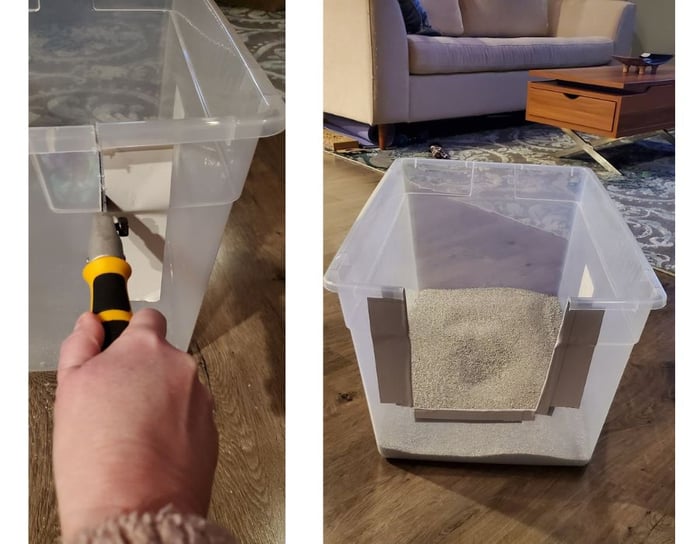
Territorial triggers
A new cat (or pet) in the home, a change in relationship with an existing pet, or a stranger cat outside can all trigger spraying. Outside cats are the reason I see most with my clients. They can cause concerns for your cat over their safety and availability of resources (food, etc.).
- Try blocking your cat's view out windows where they see outside cats. Use a decorative film or a privacy film on the bottom of the window so light can still come in and your cat can still see up into the trees and sky. If you're feeling artsy, you can use stained glass paint to obscure the view.
- Check the weather stripping around your doors and windows. The outside cat smells may be coming in with the draft, especially if they're spraying nearby.
- If your cat is spraying near windows or exterior doors, an outside cat may be spraying in those areas outside. A thorough clean-up can help. Try to remove any trace of the outside cat's sprayed scent that your cat may be smelling, whether it's on doors, walls, windows, etc. You can use soap and water or an enzymatic cleaner.
- Try deterrents, like a motion-activated spray, to show the outside cat your yard isn't the best place for them to hang out. This can often be done for short periods, just until the cat takes the hint. They'll learn to avoid your home. You may need to set the deterrents back up occasionally as a reminder.
Note: This is not recommended for use inside to deter your cat from doing something. It can cause stress and fear, which is likely to make your issues worse, not better. I only recommend it as an outdoor cat deterrent, as needed.
Here are a few other outdoor deterrent choices:
Motion-activated sprinkler
PURR…FECT Fence Conversion System for CatsA note about deterrents: Don't use anything that will cause pain or fear. You don't want to help your cat by causing another cat distress. There are humane options like motion-sensor air cans you can place by doors and windows, motion-sensor water sprinklers, rocks in front of windows that make the area uncomfortable to stand on, and even fence-top rollers or extensions to keep cats from jumping over.
Pro Tip: Make life easier while you work on the issue by using pee pads or high-sided litter boxes where your cat is spraying. You can easily tape pee pads up on the vertical surface and place one on the floor.
Sexual triggers
If your cat is not spayed or neutered, there's an increased likelihood of spraying. So, that's your primary consideration to end this behavior. There are also welfare reasons and health benefits for spaying and neutering, like decreasing the likelihood of certain cancers, pyometra in female cats, increasing life expectancy, limiting your cat's desire to explore too far from your home if they get outside, and decreasing the chances of seriously aggressive interactions with other cats.
Many people ask us if male cats spray more than females. What is true is that intact males spray more than neutered male cats, especially if there's a female around. Similarly, intact females will spray more when they're in heat, but they can also spray after being spayed. So, it's complicated!
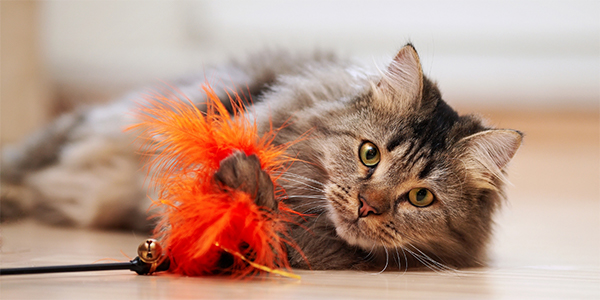
For any of these triggers, make stress reduction part of the plan. Have play sessions, set aside a few extra minutes here and there for a little bonding, and give your cat ways to engage their mind with food puzzles and brain games. These things don't take much time, but they can make a world of difference! Check out some great toys and puzzles we recommend for keeping your kitty active and content.
Cleaning Pro Tip: Cleaning cat urine effectively is vitally important when you're dealing with spraying and inappropriate soiling. Just because you can't smell it doesn't mean it's gone. Get yourself a quality enzymatic cleaner, and check out our article on cleaning house soiling.
Do You Have a New Home?
If you're new in your home and your cat starts spraying, you may be dealing with "leftover" smells and urine from the previous occupant(s). Using a black light flashlight will help you detect where these spots might be (example in the photo below). It'll detect if you haven't completely cleaned yours cat's accidents as well. There's more detail on how to use this technique in the cleaning house soiling article linked above.
Your cat may also spray in a new home because it doesn't smell like them, and that's unsettling. They'll spray to spread their scent so it feels familiar.

Phantom Cat Spraying
It's incredibly common for cats to go through the spraying body language of backing up to a vertical surface, holding the tail straight in the air, and quivering it. But they aren't discharging any urine. This is often called phantom spraying. My cat does this 20 times a day, specifically when he's excited or happy to see me. So, I suppose it's a compliment (as long as he's not actually spraying).
There are different theories on why cats do this. It's an instinctual behavior that may help them express feelings like excitement or anxiety even though they don't feel they need to spray. Until we find a way to ask them questions and understand their responses, we may never have the real answer. But it's normal behavior and no cause for concern.
When to Get Professional Feline Behavior Support
If the tips above aren't helping manage your cat's spraying, you're not out of options. There are many ways to work on spraying and the things that trigger it. Consider reaching out to a certified feline behavior consultant. They can do a deep dive into the situation and work with you to develop a behavior plan to address the issues.
Want to hear and learn more? Listen to this episode from the archives of the Paws & Play podcast with my colleague and fellow cat behavior expert at Feline Behavior Solutions, Marci Koski:





